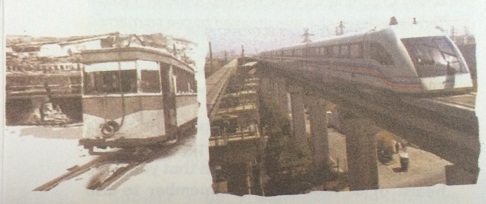Skills 1
Unit 6: Vietnam: Then and now
Skills 1
Reading
1. Work in pairs to answer the following questions.
Làm việc theo cặp rồi trả lời câu hỏi sau:

1. What are the things in the pictures? các đồ vật trong bức ảnh là gì?
→ The first picture shows an old tram. The second picture shows a modern train.
2. When and where can you see them? Bạn có thể thấy chúng khi nào và ở đâu?
→ The tram would have been seen in a town or city. These trains can be seen nowadays in big, modern cities.
3. How different are they? Chúng trông khác như thế nào?
→ They are different in many ways:
- The first has fewer compartments (two or three) than the second (four).
- The first runs much more slowly.
- The first is not air-conditioned while the second is.
- The first runs along tracks on the ground at street level, while the second runs on elevated tracks.
- The first is powered by overhead electricity wires, while the second runs on electromagnetics.
2. Now read the article from a travel magazine. Then answer the questions that follow.
Bây giờ đọc bài báo ở tạp chí du lịch. Sau đó trả lời câu hỏi sau.
THE TRAM SYSTEM IN HA NOI: THEN AND NOW
Ha Noi had its first tramways in 1900. The tram system was a major means of transport in the city for nine decades and thus the image of the tram and its clanging sounds have gone deep into the hearts and minds of Hanoians. Since it was convenient and cheap to get around the city and to the suburban areas by tram, the system was very popular. However, due to the population boom and the need for a under road system, the last rail track was removed.
Now, after more than 20 years, the population of Ha Noi has risen from about tivo million people to more than six million people; therefore, the number of vehicles on the roads has increased dramatically. To meet the increasing travel demands, Ha Noi is launching its first sky train system, connecting Cat Linh and Ha Dong. The system is expected to begin operations by 2016, with initial four-compartment skytrains. Furthermore, a new rail system project including around eight kilometres of skytrain rail and four kilometres of subway rail, connecting Ha Noi Central Station and Nhon, has also been under construction and is expected to be completed in a few years.
Dịch:
HỆ THỐNG XE ĐIỆN Ở HÀ NỘI: NGÀY ẤY VÀ BÂY GIỜ
Hà Nội có đường xe điện đầu tiên vào năm 1900. Hệ thống xe điện là 1 phương tiện vận tải chính của thành phố vào thập kỉ thứ 9 và thật vậy hình ảnh của chiếc xe điện và âm thanh leng keng của nó đã đi sâu vào trái tim và tâm trí của người Hà Nội. Bởi vì nó tiện lợi và rẻ khi đi vòng quanh thành phố và vùng ngoại ô bằng xe điện, hệ thống này đã rất phổ biến.
Ngày nay, sau hơn 20 năm, dân số của Hà Nội đã tăng từ 2 triệu người lên hơn 6 triệu người; vì vậy, số lượng phương tiện trên đường phố đã tăng đáng kể. Đế đáp ứng nhu cầu đi lại tăng cao, Hà Nội đang khai trương hệ thông tàu điện trên cao, nối liền Cát Linh và Hà Đông. Hệ thống được mong đợi sẽ bắt đầu hoạt động nào năm 2016 với 4 toa tàu điện đầu tiên. Hơn nữa, dự án hệ thống đường ray mới bao gồm 8 km đường ray xe điện trên cao và 4 km đường ray ngầm dưới mặt đất, nối liền nhà ga trung tâm Hà Nội và Nhơn đang được xây dựng và mong đợi sẽ hoàn thành trong vài năm nữa.
1. In which century was the tram system built?
→ In the 20th century
2. What was the role of the tram system in Ha Noi
→ It was a major means of transport for Hanoians.
3. When was the system removed?
→ In 1990
4. What has happened to Ha Noi's population over the last two decades?
→ The population has increased dramatically
5. How has the tram system in Ha Noi been improved recently?
→ New rail systems including a skytrain and a subway are under way.
6. Which of the transport systems do you think : more impressive to Hanoians?
→ I think is the BRT in Hanoi
3. Decide if the following statements are true (T) or false (F).
Xem những câu sau là đúng (T) hay sai (F)
1. The purpose of the passage is to persuac-e people to go by skytrain. → F
2. Hanoians were deeply attached to their trar system. → T
3. The tram system of Ha Noi only operated in thr downtown area. → F
4. There has been a sharp increase in the number of vehicles in Ha Noi. → T
5. The new skytrain has been running for two years. → F
Dịch:
1. Mục đích của đoạn văn là thuyết phục mọi người đi xe điện trên cao.
2. Người Hà Nội gắn bó sâu sắc với hệ thông tàu điện của họ.
3. Hệ thống xe điện của Hà Nội chỉ hoạt động ở khu vực thành thị.
4. Có sự tăng nhanh số lượng phương tiện ở Hà Nội.
5. Hệ thông tàu điện trên cao mới đã chạy được 2 năm.
4. Work in pairs. List different types of traditional and modern transport systems in Viet Nam.
Làm việc theo cặp. Liệt kê các loại phương tiện giao thông truyền thống và hiện đại ở Việt Nam.
|
Past |
|
|
Present |
|
5. Discuss the changes in transport in your neighbourhood. Is there anything that you prefer about the traditional/modem transport systems where you live?
Thảo luận những thay đổi trong giao thông ở vùng xung quanh bạn. Có điều gì bạn thích hơn ở giao thông truyền thống hoặc hiện đại nơi bạn sống không?
Ví dụ: Tôi thích sử dụng lối đi dành cho người đi bộ hơn là vỉa hè trên những con đường đông đúc ở thành phố của tôi bởi vì nó an toàn hơn nhiều cho bộ hành và ở đó ít ô nhiễm hơn.
Những con đường ở làng tôi đã thay đổi đáng kể. Nhưng tôi thích những con đường đất hơn là đường bê tông bởi vì làng quê trông "xanh hơn" với những con đường đó.
Bài tập
- Bài 1. Work in pairs to answer the following questions.
- Bài 2. Now read the article from a travel magazine. Then answer the questions that follow.
- Bài 3. Decide if the following statements are true (T) or false (F).
- Bài 4. Work in pairs. List different types of traditional and modern transport systems in Viet Nam.




